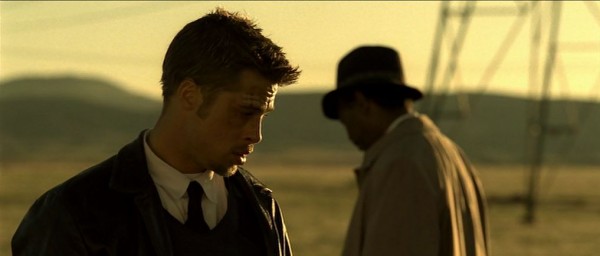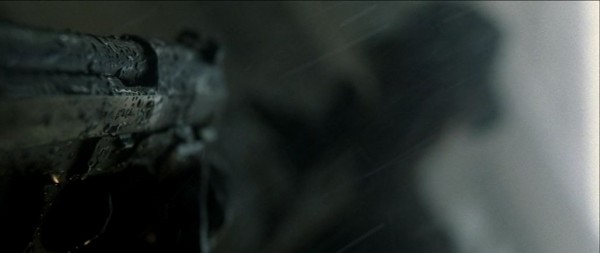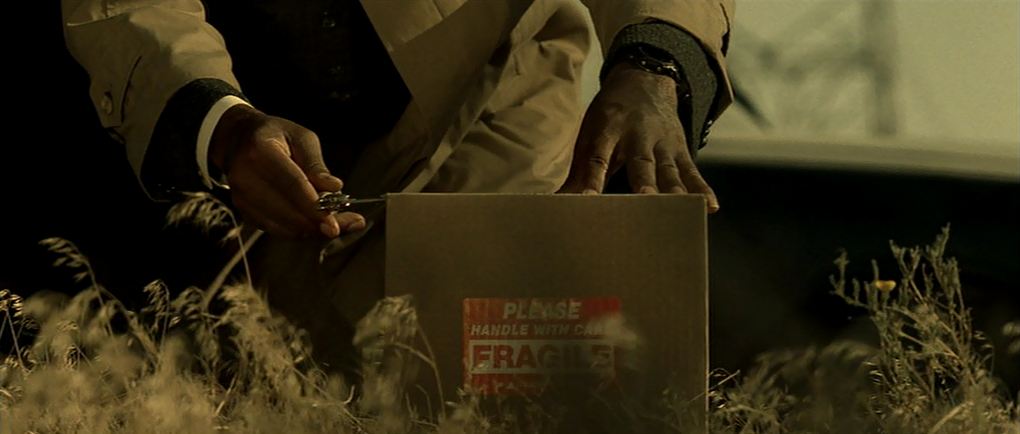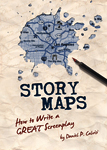Seven screenplay analysis and free download offer
Seven, written by Andrew Kevin Walker and directed by David Fincher, is one of the great thrillers of the 1990s, a decade with several exceptional thrillers. Walker’s screenplay for Seven shot him to the Script Doctor A-list, establishing him as a hot writer of dark material on spec, like 1999’s 8mm, as well as garnering him uncredited rewrites on films such as Fight Club, The Game (also Fincher-directed films) and Stir of Echoes (directed by Walker’s mentor, David Koepp).
David Fincher was well-established as a music video director, but his first foray into feature films, 1992’s Alien 3, was a debacle. He was hired to replace the first director on the film, already in production, so he never got the chance to fully develop the script and give the film his stamp. Seven is the film that really put Fincher on the map as one of our great cinematic stylists, and he would follow it up with a string of powerful films over the years, including Fight Club, The Social Network and the remake of The Girl With The Dragon Tattoo. [Note: this Indiewire article treats Seven, Zodiac and Dragon Tattoo as Fincher’s “serial killer trilogy,” if you’re interested.]
Click here to read an excerpt
from the Full Story Map of Seven
Fincher always works with great writers, but he enhances each script by putting his indelible visual and tonal stamp on his films. This has never been so true as with Seven. From all accounts, Walker’s script was a rather formulaic, high-concept thriller built around the premise of a killer who re-enacts the seven deadly sins. A cat-and-mouse game between a twisted serial killer and two cops, one young and brash and the other close to retirement…is not exactly a revelatory set of dramatic elements. It was Fincher who made the location a nameless, hopelessly bleak, always rainy city, gave it tons of Noir details (the high contrast lighting, hard-boiled clothing and period cars all reflect an older era) infused with an industrial punk aesthetic, and hired a visual effects team to create the striking opening titles and end credits sequence. Fincher wisely hired two brilliant key personnel–cinematographer Darius Khondji and production designer Arthur Max–to help him deliver the dirty, oppressive, nihilistic vision of modern life that elevated Walker’s script to an iconic film. An incredible image like this, copied so many times since on the big and small screen, could only have come from Fincher and his team in this era…
The reveal of the killer’s identity is one of the film’s signature moments. According to this bit of IMdb trivia, it was Kevin Spacey who requested to have his name removed from the poster and press packet for the film, so as to surprise the audience when John Doe finally appears onscreen. Spacey was not yet a full-fledged movie star, as his film The Usual Suspects (another great 90s crime film), had only opened one month prior to Seven, so his cameo was exciting for audiences who recognized him from his various character roles.
The pacing of the film is alternately fast and slow; with seven crime scenes to get through, the pace must be kept up, but, one notices that there are several long scenes in the film. The filmmakers draw out many moments to deftly escalate tension and to create the mood of dread and hopelessness that is so key to the theme of the story. Interestingly, Fincher often chooses to wait until the end of a scene to reveal a key detail, so we, the audience, feel like we are discovering these clues along with the protagonists. In fact, he takes it one step further on multiple occasions, when we find out a crucial detail after the detectives, so we often feel a slight step behind them, which ratchets up that gnawing sense of discomfort that has been building in us since the opening scene of the film. Putting these reveals at the end of a scene adds a jolt to the beat to propel us into the next scene. An example would be when Detective Mills (Brad Pitt) walks the crime scene of Defense Attorney Eli Gould; there’s no way he could have missed the message on the floor written in blood, but we don’t get to see it until the end of the scene…
Purchase my e-book “12 Great Screenplays” to get an exclusive
Full Story Map of Seven (not in the Kindle version)
When the pace picks up, the action is intense, such as with two memorable set pieces: the SWAT team storming Victor’s apartment (the man who’s been starved to a near-corpse) and Mills chasing John Doe through the alley in a torrential downpour. Both culminate in shocking beats that raise the stakes and establish nice setups that will pay off later.
A script is only as good as its story engines, and here we’ve got a natural spine built into the bones of the story–the device of the Seven Deadly Sins, and the parallel countdown of the seven days until Somerset’s retirement–form an elegant and effective framing device for the story. But character is also important here, so we take periodic breaks from the External line to bask in slower dialogue scenes, like when Tracy Mills (Gwyneth Paltrow) meets with Detective William Somerset (Morgan Freeman) to ask for his counsel about her unborn child, or David Mills tries to convince Somerset not to leave town. These scenes are focused like a laser beam on the screenplay’s Controlling Theme, one of the key elements in the Basic Story Map.
MILLS I don't think you're quitting because you believe these things you say. You want to believe them, because you're quitting.
Click here to read an excerpt
from the Full Story Map of Seven
Throughout the film, we’re left wondering…Why? Why is this killer murdering his victims to reflect the seven deadly sins from Dante’s The Divine Comedy? This question is answered in the final act, which is dominated by an extended dialogue sequence, featuring a chilling monologue by Spacey’s John Doe wherein he explains his theory about his victims’ culpability in their own horrible deaths. I happen to love talky third acts, as in films like Kill Bill: Volume 2, The Matrix: Reloaded and Eyes Wide Shut, as they subvert our expectations of third act full-throttle action, and escalate the tension leading up to the climax of the movie.
As Doe leads them on the final drive (under the assumption that they are going to the resting place of his final two victims), Somerset and Mills play “good cop, bad cop,” but it’s not just an interrogation device — it cuts to the core of their opposing perspectives on John Doe, life in the city and law enforcement. Mills believes that Doe’s murder spree is motivated by mental illness, whereas Somerset believes Doe is more a product of their terrible world, “a place that nurtures apathy as if it is a virtue.”
In other words, Mills is nature and Somerset is nurture. Their diametrically opposed characters have created lots of fine dramatic conflict throughout the story, but only Somerset will be rewarded with an arc of change. Mills is in for something different.
Ultimately, Seven wouldn’t be such a great thriller without such a great ending. Who can forget what the delivery van brings to the scene?
The setup to this payoff is brilliant in its simplicity. There’s no way for us to predict what might happen when they reach the destination John Doe has led them to — after all, he’s an unarmed man locked in the back of a squad car — what could he possibly do? It’s exactly this lack of elements that keeps us on edge as we hurtle to the climax. But we soon see Doe’s master plan unfurl to completion, as the final two sins, Envy and Wrath, materialize in deadly form and a detective is irrevocably scarred by tragedy.
In conclusion, if you’re looking to write a powerhouse thriller, I suggest you study Seven. To aid you in this pursuit, I’ve written a full analysis of the structure of the film, using my Story Maps method, which is detailed in my book, Story Maps: How to Write a GREAT Screenplay. Here is an excerpt from the Seven map, to give you a taste of my analysis, and you will find the full map in my e-book “12 Great Screenplays” available HERE on its own and in a BUNDLE offer which includes a free Story Map.
Good Luck and Happy Writing,
Dan
p.s. Okay, as to the elephant in the room during any discussion of this film, let’s settle this: the name of the film is NOT “Se7en,” it’s Seven. That’s the name on the poster and the video, the name that the film was released as and registered under, and the title on the cover page of the Seven screenplay! No, I don’t care what IMdb says, as the listing was only changed to Se7en after a silly campaign by fans. Get over it, geeks, and let’s move on. 😉
“There is a lot of great advice here…
Most important, as I read Calvisi’s Story Maps,
I was inspired to rethink my current project.
And that’s what it’s all about, right?”
-Script Magazine
“Dan’s book will help you
do what you must do to
succeed with your screenplay.”
-Ken Dancyger, Author of
Broadcast Writing, Alternative Scriptwriting,
and The Technique of Film and
Video Editing (Focal Press)








Hi Dan. I love “Seven”. I think I qualify for the free “Seven” story map. Got the e-book with a script analysis package. Thnx in advance.
Hi, Dan. I bought Story Maps 12 great screen plays and it’s so helpful. I look forward Se7en story map! Thank you!
Learnt a lot from Story Map. I look forward to the Map for Seven
Thanks
Adarsh
I’m enjoying the Story Map -- it is very helpful! I look forward to the Map for Seven!
Thanks.
Sharon
Thanks Sharon. I see you bought a Story Maps e-book bundle back in October so I’m sending you the “Seven” Story Map now. Enjoy. 🙂
Hi Dan. I love “Seven”. I think I qualify for the free “Seven” story map. Got the e-book with a script analysis package. Thnx in advance.
Just emailed it to you, Eric. Enjoy, and keep in touch. 🙂